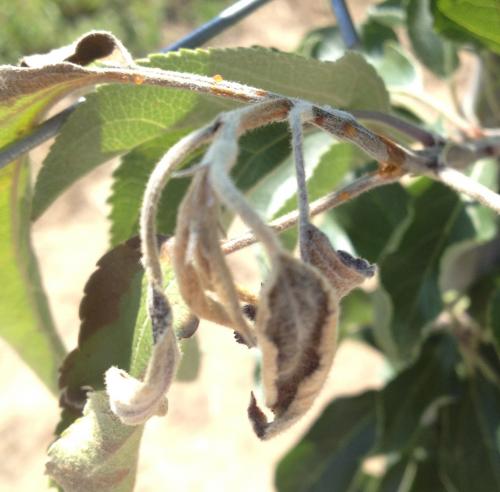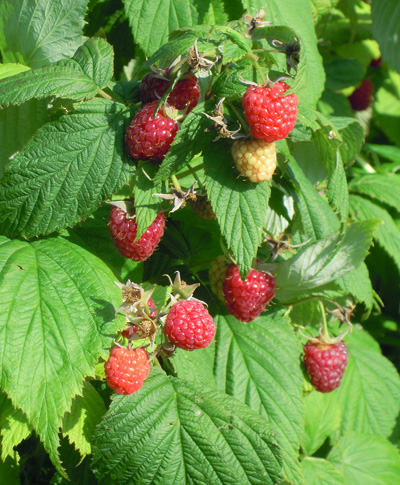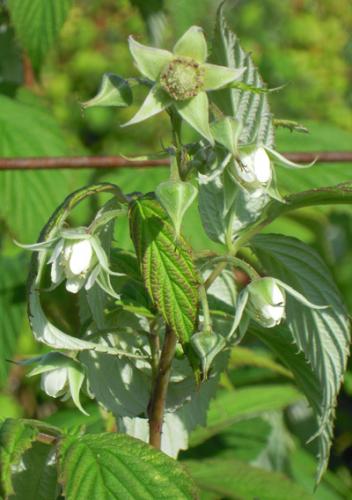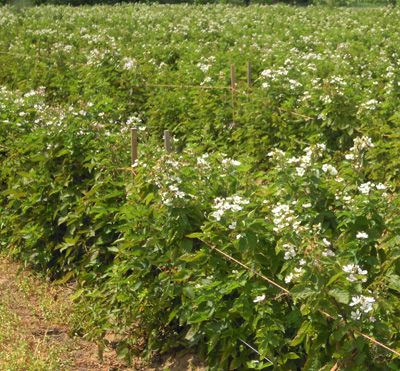Southwest Michigan fruit regional report – July 28, 2015
Peach harvest picks up steam. Oriental fruit moth and San Jose scale numbers are high.

Weather
Last week was dry. High temperatures were generally in the 80s and lows in the 50s. There was no significant rainfall last and lighter soils are beginning to dry. Some growers are irrigating on sandy soils. Evapotranspiration last week was about 1.2 inches and is expected to be about 0.2 inches of water a day this week.
Weather for the upcoming week will be warm. Highs will be in the upper 80s and lows in the 60s. There will be a chance of thunderstorms Wednesday, July 29, and over the weekend. Last week, we picked up about 29 growing degree days (GDD) base 42, 26 GDD base 45 and 21 base 50 per day. This was almost the same as last week and we expect similar heat accumulations this week. We are about a week behind normal in heat accumulation and rainfall is about an inch above normal.
Southwest Michigan GDD summary from March 1 through July 26, 2015 |
|||
|---|---|---|---|
|
Station |
GDD 42 F |
GDD 45 F |
GDD 50 F |
|
Benton Harbor (SWMRC) |
2,336 |
2,007 |
1,510 |
|
Lawton (Lawton) |
2,327 |
2,000 |
1,501 |
|
Fennville (TNRC) |
2,127 |
1,814 |
1,339 |
|
Average for the region |
2,304 |
1,975 |
1,477 |
|
Accumulation last week |
205 |
183 |
146 |
Tree fruit
Soil moisture is low in top soil, but reserves are still available in the subsoil. Foliar diseases are common in some orchards. Oriental fruit moth is still flying. Obliquebanded leafroller larvae of the second generation can be found webbing leaves and chewing holes in foliage. The Trevor Nichols Research Center (TNRC) reports first trap catch of San Jose scale male adults July 20 with a huge increase for this week. San Jose crawlers are expected approximately 500 GDD51 from biofix, or approximately the end of next week, depending on the temperature. Sprays for crawlers are timed shortly after crawlers emerge, about 650 GDD51 after the July 20 biofix.
Apricot harvest is about over. A few late varieties are still harvesting.
Peaches are growing rapidly. Split pits are common on some early season peach varieties with light crops. Peach varieties being harvested now or shortly include Brightstar, Garnet Beauty and Summer Serenade. Redhaven is about one week away in central Berrien County. A peach maturity and harvest model is available on the Michigan State University Enviro-weather website. See “Peach harvest dates available on MSU Enviro-weather” from Michigan State University Extension for more information. We are interested in grower feedback on the accuracy of this model from growers who use it to predict harvest in their orchards.
Brown rot is becoming a problem with ripening fruit and warm weather and on fruit damaged by split pits and insects. Growers should remember to rotate fungicide types to avoid resistance problems. Bacterial spot problems are much less than last year. Mycoshield (21-daypre-harvest interval or PHI) can be used to help keep bacterial spot on foliage from spreading to fruit. Oriental fruit moth trap catches are high in some orchards. Other direct fruit pests include tarnished plant bugs and common stink bugs, which cause pinhole punctures on fruit. Peach tree borer moths are still flying in area orchards and have the potential for egglaying in limb and trunk wounds.
Sweet cherry harvest has ended. Cherry leaf spot symptoms are easy to find. Growers need to maintain protectant fungicide coverage before rain events. Modest pruning can be done post-harvest on mature trees that have filled their space.
Tart cherry harvest has ended in southwest Michigan. Cherry leaf spot has defoliated some orchards. Most growers applied chlorothalonil after harvest to protect their remaining leaves. Since it has not rained, growers using copper should avoid copper building up on leaves and discontinue copper use when there is little or no rain between sprays. Powdery mildew is common in many orchards.
There was a strong flight of greater peachtree borers and lesser peachtree borers. Treat with trunk sprays after harvest to prevent these pests. Like in sweet cherries, modest pruning can be done post-harvest on mature trees that have filled their space. Unharvested cherries on the tree are prone to infestations by cherry fruit flies and spotted winged Drosophila (SWD) vinegar flies. It probably does not pay to apply a revenge spray to kill these pests unless you have ripening fruit in the area and need to keep pest pressure down.
Japanese plum harvest of Shiro, Vibrant, Early Magic and Ozark Premier is or will shortly be underway. Apple maggots, oriental fruit moths, codling moths and obliquebanded leafrollers can infest fruit if it is not protected.
Apple estimated harvest dates are available from MSU Enviro-weather for weather stations across Michigan. Some of these dates include Sept. 8 for McIntosh and Sept. 30 for Red Delicious for central Berrien County. View a more detailed list of apple variety harvest dates for west central and southwest Michigan.
Apple maggot adults were caught for the second week at the TNRC. Trapping with yellow sticky boards is a good method to determine if it is present. Hot weather and rains over the past few weeks have continued to make fire blight active with abundant ooze in orchards with active terminal growth. The fungal disease bitter rot can be found on fruit. Growers need to include fungicides in some of their cover sprays to control sooty blotch and flyspeck. Growers should reapply fungicides for these two diseases whenever the hours of leaf wetness exceed 250 since the last fungicide application.
Growers with a light crop or with bitter pit-susceptible varieties should include calcium in their cover sprays to reduce bitter pit. We are still catching codling moth of the second generation flight. Oriental fruit moth trap catches are high in some orchards. Growers should be scouting for obliquebanded leafroller larvae. Green aphids are increasing on active shoot growth.

Amber-colored fire blight ooze on an apple shoot. Photo by Bill Shane, MSU Extension
Pear crop potential is good. Clapp Favorite harvest is about two weeks away.
Small fruit
Japanese beetles are easy to find. We are catching more spotted wing Drosophila (SWD) in southwest Michigan. Almost all traps are catching flies and trap numbers are doubling each week. SWD is a pest of ripening fruit and numbers increase as wild berries ripen.
Grapes are at cluster tightening. Vinifera grapes can still be infected by black rot, but develop resistance to downy mildew and powdery mildew by this point in the season. Wine grape growers should apply a Botrytis fungicide before bunch closure to reduce late-season fruit rots. Black rot fruit infections that occurred when juice grapes were susceptible to the disease are showing symptoms now. The third generation of grape berry moth is predicted to begin egglaying at the end of next week or the beginning of the following week. See “Grape berry moth pressure lower in 2015 – control window approaching for southern Michigan” for more information.
In wine grapes, scout for potato leafhoppers, which are in the area. Grape leafhoppers are scarce in juice grapes. Japanese beetles are feeding on leaves in some vineyards, and have been seen in greater numbers this week. Usually, only severe outbreaks of these insects require treatment.
Blueberry machine harvest is well underway and blueberry harvesters are a common sight. Bluecrop is the major variety being harvested now. Jersey harvest is just beginning. Locations close to Lake Michigan are a week or more behind inland sites. In these locations, Bluecrop harvest is just beginning.
Scouts are catching blueberry maggot flies and SWD. In non-irrigated fields, blueberry maggot numbers are decreasing without any rain, but SWD numbers are doubling every week in most locations. Ripening fruit needs to be protected from these pests. Frequent picking reduces the amount of time the fruit is availble to these pests. Growers should be testing fruit for larvae – many soft fruit are infested. Growers should apply fungicides to protect fruit from anthracnose and alternaria fruit rots and new shoots from stem blights such as phomopsis.
Soil conditions are dry and irrigation systems should be running. The potential evapotranspiration is about one-fifth of an inch per day or about an inch and a half of water a week. On sandy sites, this is about all the available water in the rooting zone of blueberries (about 18 to 24 inches). Under these hot, dry conditions, mature blueberry bushes use about 3 to 4 gallons of water a day. Growers need to maintain soil moisture above 50 percent available water in the root zone.
Strawberry fields are putting out new leaves after renovation. Growth is good in irrigated fields, but poor in unirrigated fields. Protect newly emerging leaves against strawberry foliar diseases
Raspberry harvest is winding down in summer red raspberries. SWD and Japanese beetles are out and can be a problem in raspberries. Primocanes are blooming on early fall bearing red raspberries. Primocane-bearing blackberries are also blooming. Protect pollinating bees and avoid spraying insecticides during bloom. This is a problem for growers trying to double crop ever-bearing red raspberries with fruit on floricanes and bloom on primocanes. Growers with ripening fruit need to time their SWD controls with harvest and pay close attention to the PHI on the pesticide label. Raspberries are also very attractive to SWD and growers should pay close attention to protecting against this pest.

Floricane fruit: Summer red raspberries develop on lateral branches of last year’s shoot called a floricane. Photo by Mark Longstroth, MSU Extension

Primocane bloom: Fall red raspberries develop at the tips of this year’s shoots called primocanes. Photo by Mark Longstroth, MSU Extension

Bloom in primocane bearing blackberries. This bloom is on new shoots that grew this year. Photo by Mark Longstroth, MSU Extension
See also
- Controlling cherry leaf spot in orchards with existing symptoms
- Peach harvest dates available on MSU Enviro-weather
- Sooty blotch and flyspeck disease of apple and pear
- Bitterpit control in apples
- Predicted 2015 apple harvest dates
- Managing Japanese beetles in fruit crops
- Don’t let bunch rots ruin your grapes
- MSU Spotted Wing Drosophila website
- Where else does spotted wing Drosophila like to feed?
- Assistance in raspberry virus diagnosis offered
- Protect strawberries from foliar diseases after renovation



 Print
Print Email
Email
